This figure is technically a repaint of the original sculpt, but since it wasn’t reviewed here yet, I feel I might as well give some background on the production of it. For starters, Raul Ramos initially sculpted a 3D model of the skull (first revealed on July 6 2019), which was then printed and served as a base, for sculptor Simon Panek to use for the final flesh reconstruction of the figure (revealed July 8, 2019). Other parts used in the figure’s makeup were sculpted by both Jake Baardse, and David Silva, which were shared among some of the other similarly sized ceratopsians (in particular the body type 3 ceratopsians Styracosaurus, Wendiceratops, the sub-adult Triceratops, and Regaliceratops, but mostly with the former two). It was the one of the earlier stretch goals unlocked during the 2019 Ceratopsian Series kickstarter, with the original figure releasing in late 2020. This particular Fan’s Choice version of the figure came about from the results of a poll held in January 2022, coming in fourth place. The coloration for this particular version was based on the iridescent white-lipped python, and David Silva painted the prototype… more on that later. The beautiful package art for this figure was done by Raph Lomotan, and the packaging also includes a background insert based on the sunset and conifer forest scenery featured in the package art, as well as a collector’s card like other figures in the series. The tail also comes separately like the other figures in the series, and needs to be heated up before attaching it.

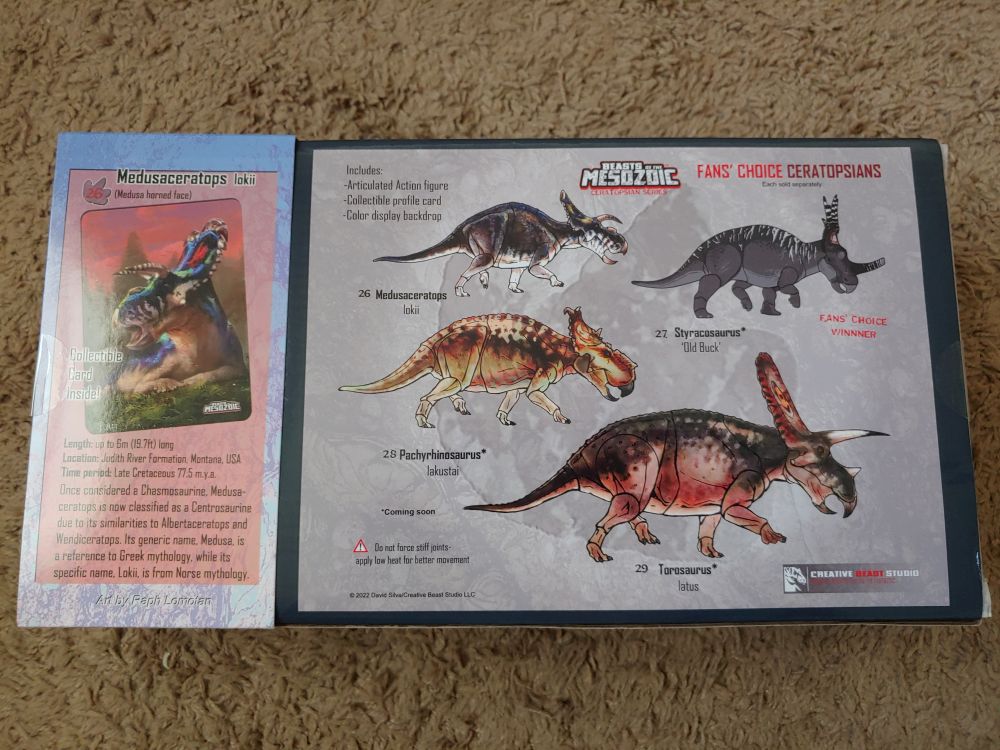
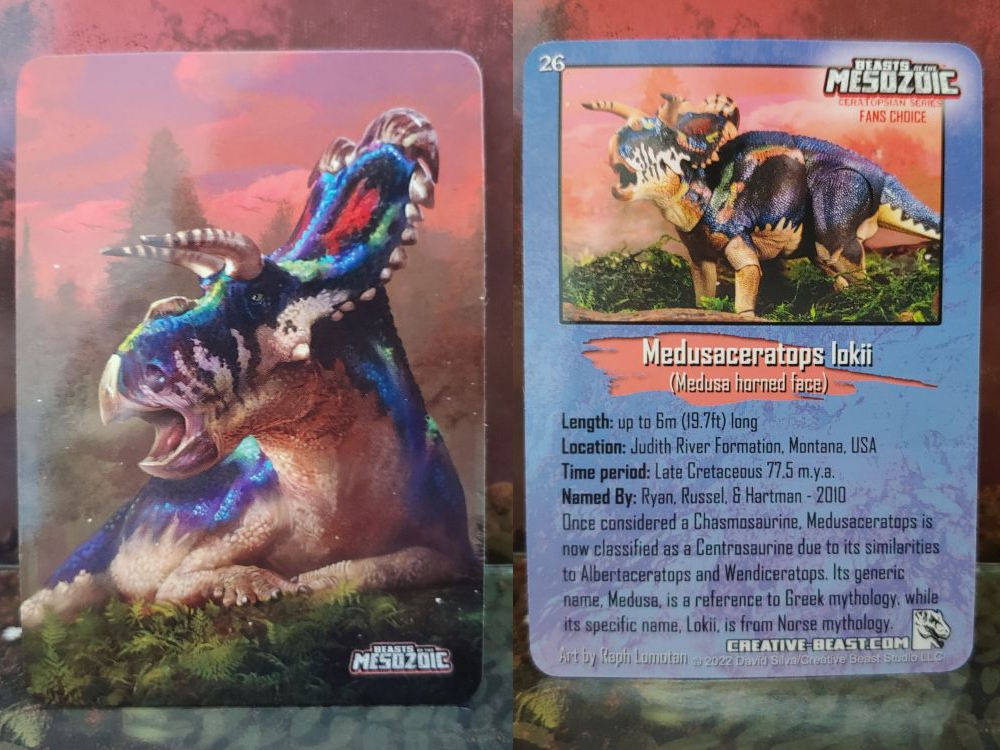
Now for some history on Medusaceratops itself. The fossil material was discovered in the Mansfield Bonebed, located in the Judith River Formation, in Montana, from the middle Campanian, Late Cretaceous period, 77.5 Ma. Some animals from the formation include Avaceratops, recently described Daspletosaurus wilsoni and Furcatoceratops, Spiclypeus, and Zuul. The name comes from combining Medusa, a famous monster from Greek mythology, and “ceratops” meaning horned face. The species name lokii, which comes from the trickster god Loki, of Norse mythology, was given due to the troubled history of what the bonebed material belonged to. At one point, some of the bonebed material was thought to belong to Albertaceratops (Michael J. Ryan, 2007), and even Styracosaurus earlier on (Sweeney and Boyden, 1993). In the case of the former Albertaceratops, it was found in the Oldman Formation in Alberta, Canada, contemporaneous to the Judith River Formation, and about 16 km/9.94 miles north of where the Medusaceratops bonebed material was found. Ryan eventually realized the Montana bonebed material did not belong to Albertaceratops, but a different genus altogether, which was finally named and described in a 2010 paper with co-authors Anthony P. Russell, and Scott Hartman. The holotype (WDC-DJR-001) and paratype (WDC-DJR-002) material were partial parietals, or parts of the frill, as the other disarticulated (mostly postcranial) material from the bone bed was undiagnostic to any particular ceratopsian. Both papers mentioned that the material (though not most of the diagnostic parietal material from Medusaceratops) was also cast and used in the mounts WDBC MC-001, and FPDM-V-10 (reconstructed as a chasmosaurine or “Chasmosaurus sp.”), located at the Wyoming Dinosaur Center, and the Fukui Prefectural Dinosaur Museum, respectively, with other material located at the Royal Tyrrell Museum, or potentially owned in private collections. The FPDM-V-10 mount in particular used some original postcranial material from the bonebed, and includes a skull mixed with both original and sculpted elements, while the mount WDBC MC-001 consists of a partial skull, reported to have large postorbital horns. To confound things further the original material as it was excavated was not done so in a scientific manner, leaving no taphonomic data to assess the material, as it was excavated commercially.
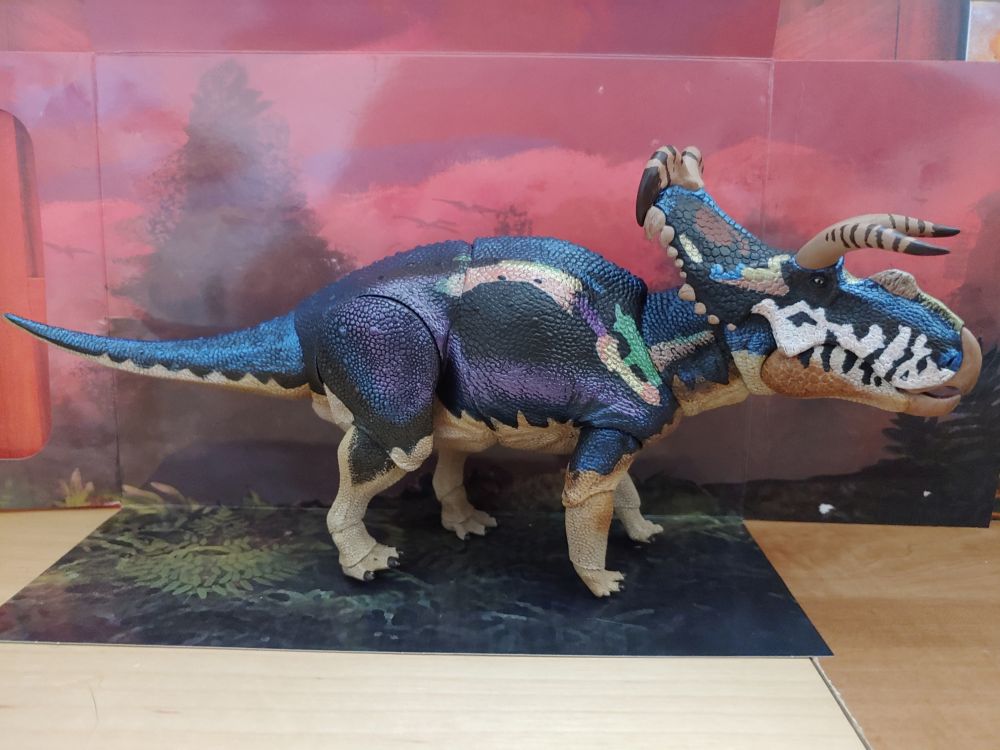
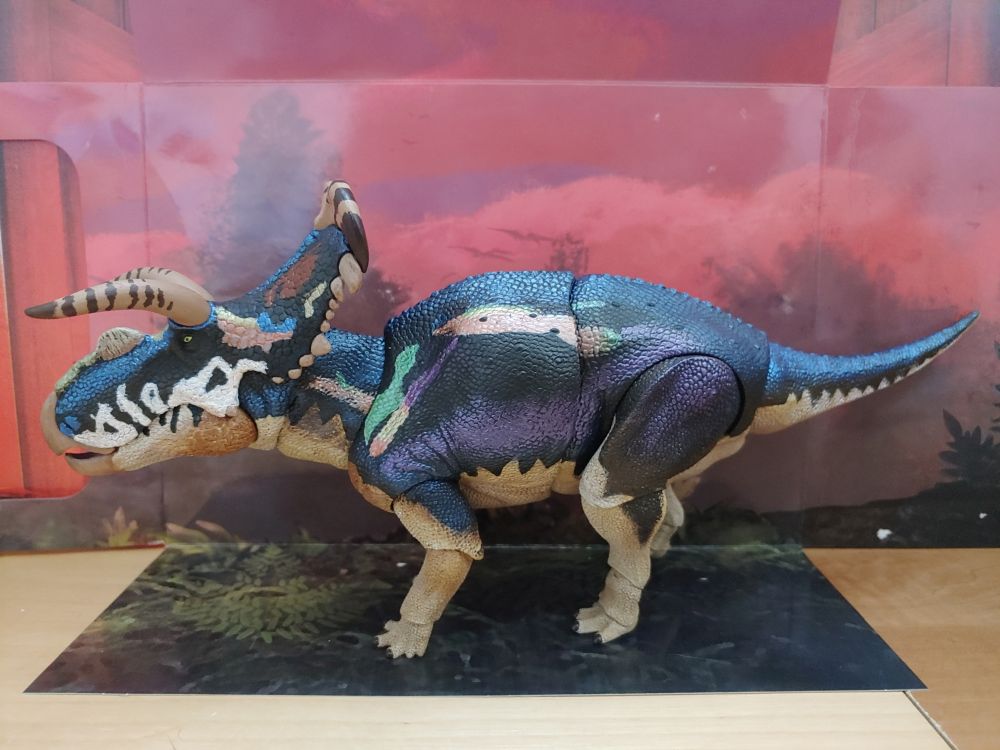
When Medusaceratops was described as a new genus in 2010 it was thought to be the oldest chasmosaurine discovered, but other material from the bonebed found in the early 2010’s, and later described in 2017 from authors Kentaro Chiba, Michael J. Ryan, et al, showed that it was a centrosaurine. The new material, also parietals, showed that it had at least five epiparietals on the frill, a characteristic of centrosaurines, and not three, as thought earlier on. This paper also infers that all ceratopsid material from this bonebed were actually centrosaurine in origin, and possibly all from the same species, and therefore referred it to Medusaceratops. There was also a correction for the paratype material. The material stated to be from WDC-DJR-002 in the original Medusaceratops paper had belonged to TMP 2002.069.0005, though the paper does retain material from WDC-DJR-002 as the paratype. Additionally, while it was stated in the previous Albertaceratops and Medusaceratops papers that the material used in the mount WDCB-MC-001 was from the Mansfield Bonebed, new data used in the 2017 paper suggested it originated elsewhere (its horncore material is also shorter then the bonebed material), and was excluded from the hypodigm (overall material) from Medusaceratops. Some of the material is also stated to be from juvenile specimens (such as some of the skull elements used in the mount FPDM-V-10, and specimen ROM 77214), though most is from larger adults. Some of the referred material includes other parts of the skull (dentaries, postorbitals, squamosals, nasals, maxillae, etc), and some postcranial material (sternum, ilium, metatarsal, and other material from both the mount FPDM-V-10, and a composite skeleton WDC-DJR-1000).

With how fragmentary the material is, there isn’t too much to be concerned about as far as accuracy of the figure goes. It has your typical ceratopsid bauplan, with five digits on the hands (only the first three clawed), and four on the toes, with a short tail, and large head with beak, teeth, and frill. As far as the head goes, the material is represented pretty faithfully here as far as I can tell, including those two distinctive large curved horns at the top of the frill. The sculpt measures about 12 inches/30.48 cm long (according to the Creative Beast Studio website), and like most of the other figures in the Beasts of the Mesozoic Ceratopsian Series, is intended to be 1/18 in scale. The brow horns, and nasal boss seem similar to the reconstruction in the original 2010 paper by Donna Sloan, in which the paper mentions was based on holotype specimen WDC-DJR-001, and other “chasmosaurine” material from the bonebed, now considered to belong to Medusaceratops per the 2017 paper. The skin is covered in fine scales, and larger bumpy ones of various shapes, the largest of which are on the legs. While Medusaceratops itself has no preserved skin impressions, some of its ceratopsian relatives do, including Psittacosaurus, potentially Protoceratops, fellow centrosaurines Nasutoceratops and Centrosaurus, and chasmosaurines Chasmosaurus and Triceratops.
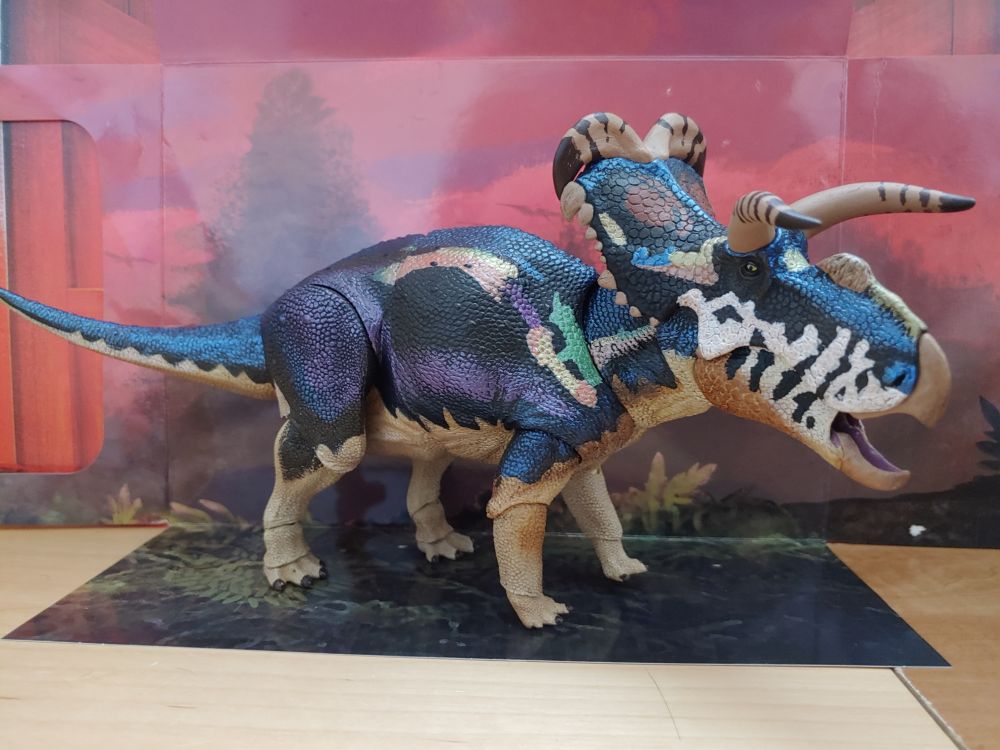
In the case of Nasutoceratops, small patches of basement scales of various shapes were found alongside the scapula and humerus in specimen UMNH VP 16800, most notably were the 8–11 mm sized hexagonal shapes scales. This was described in detail in a 2016 paper by Eric K. Lund et al. Some specimens of Psittacosaurus also seem to reflect this morphology, including YFM-R001, and SMF R 4970 (including on the hind limb). I’m not so sure this has been replicated on the figure though, in comparison to the Nasutoceratops possibly (and others sharing its limb parts). Centrosaurus has skin material from both the right flank, and the tail, from several specimens (AMNH FARB 5351, AMNH FARB 5427, TMP 1986.018.0097), but most notably from specimen AMNH 5427. Specimen AMNH 5427, was initially described as a specimen of Monoclonius in an 1917 paper by Barnum Brown, and later as Centrosaurus in a 1933 paper by Richard Swann Lull. This material was found on the right thoracic region of the animal and consists of irregular rows of small polygonal basement scales, with some larger round feature scales, less than 5 cm in diameter. The material from the tail is a small patch of 3–6 mm polygonal basement scales found on specimen TMP 1986.018.0097, reported in a 2022 paper from authors Phil R. Bell et al. Most of the scales on the figure, particularly the torso seem reflective of this material, though the arrangement of the larger feature scales is speculative when compared to the available material for Centrosaurus, which preserves at least only one feature scale. Perhaps the placement of the feature scales is based upon that of the chasmosaurine Chasmosaurus belli. The scales on the legs also seem reflective of the material from C. belli, considering the size and arrangement, but perhaps further spaced apart (see below). At least two specimens of Chasmosaurus belli have been reported to have been found with some skin impressions, UALVP 52613, a juvenile (Philip J. Currie et al, 2016), and CMN 2245, an adult (Lawrence M. Lambe, 1914; Charles M. Sternberg, 1925; Lull, 1933). The material from the adult Chamosaurus specimen CMN 2245 was also found in a similar area as on Centrosaurus. It had irregular, longitudinal rows of the feature scales, spaced about 5–10 cm/2-4 inches apart, among the smaller polygonal basement scales. Some were around 5.7 cm/2.25 inches in size, and in general they were larger on the dorsal part of the body, decreasing in size down the leg. The 1925 paper by Sternberg also suggests there may have been a varied colored pattern among the different scale shapes. The juvenile specimen UALVP 52613 has a similar arrangement of feature scales and polygonal basement scales, found covering the left flank from the rib cage to the femur.

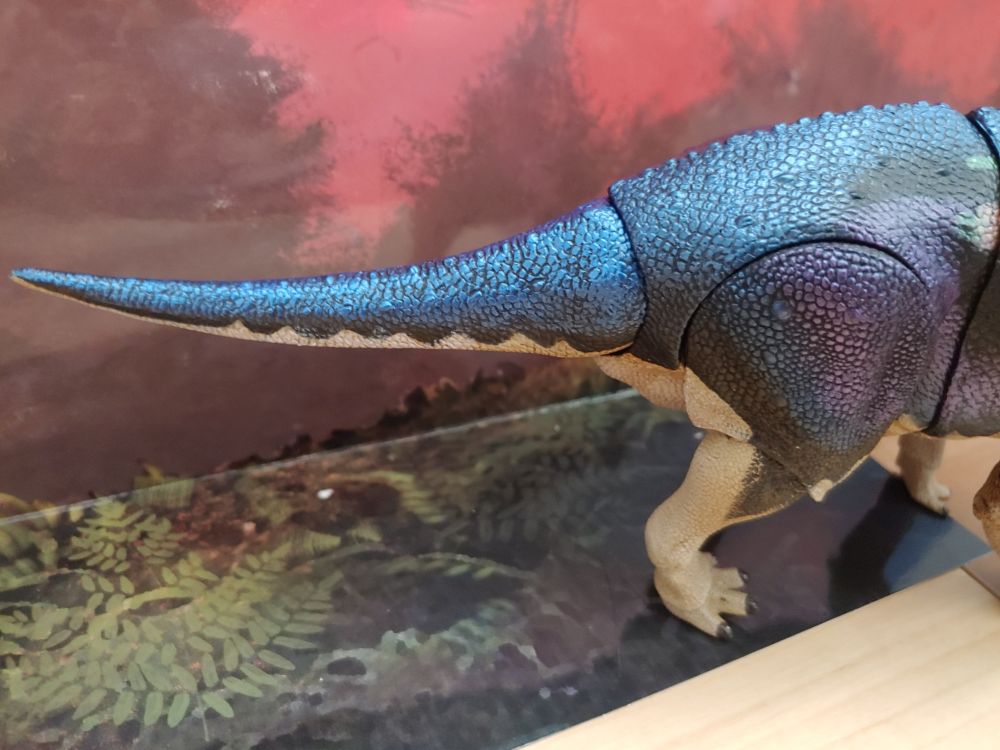
The figure has various smaller scales on the snout, and larger polygonal scales on the frill and lower jaw. It is aesthetically pleasing, but speculative with the limited material out there. Skin from the heads of ceratopsians is pretty much lacking, and aside from the incredibly preserved Psittacosaurus specimen SMF R 4970 (Phill R. Bell et al, 2022, and numerous prior papers), the only other material from the heads of ceratopsians have been found within Protoceratops andrewsi potentially (specimen AMNH FARB 6418, Brown and Schlaikjer, 1940), and chasmosaurine Triceratops prorsus (specimen CMNFV 56508, Alan McDonald, 2018). The former Protoceratops may have had tiny polygonal basement scales on the beak, frill, and the jugals, while the latter Triceratops has been found with small basement scales (and potentially epidermal scales), which was previously thought to have a keratin covering on it. Neither specimen was described in great detail (and in the case of Protoceratops, some of the material has been destroyed during preparation of the skull, although not all has been lost), but the 2022 paper from Bell et al briefly touches upon them. Furthermore a 2009 paper from Tobin L. Hieronymus et al also infers rows of epidermal scales along different parts of the skull, frill, and around the eyes (nasal, supraorbital – squamosal, parietal, epiparietal – episquamosal), along with nasal horn sheaths for centrosaurines including Centrosaurus, Einiosaurus, Achelousaurus, and Pachyrhinosaurus, based on osteological and histological correlates of extant species, and the fossilized remains. There does appear to be some degree of this on the sculpt, but the larger polygonal scales on the frill does not line up with the minimal evidence suggesting smaller basement scales were present. Additionally it might be also worth mentioning the skull has been depicted with fleshy cheeks of sorts, which seems debatable, after a 2018 paper by Ali Nabavizadeh, which suggests a more familiar theropod-like muscular arrangement for their jaws (or something similar at a glance).
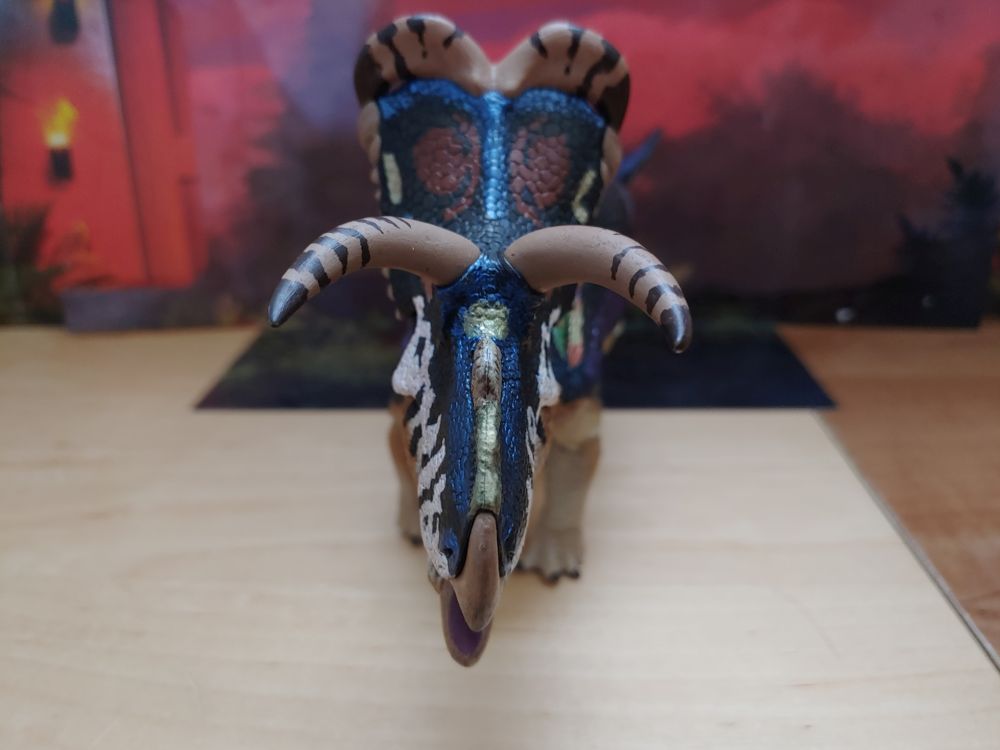
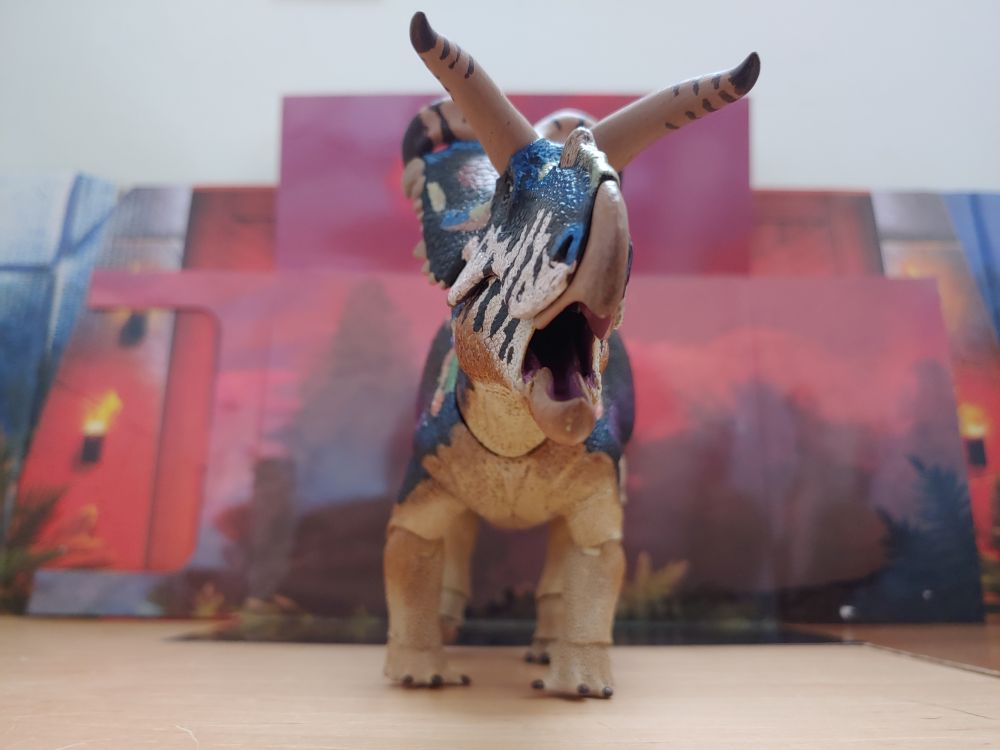
Despite my huge haul of ceratopsians that arrived to me last year, this is only the second ceratopsian I’ve had the joy to open up and experience (the first being the Kickstarter Exclusive “Monoclonius”), as a very complicated and rough housing situation has caused me to move the rest into my family’s storage unit shortly after receiving them. I don’t really have a good grasp on what to compare it to in the same series for the articulation, other then some of the reviews I’ve seen before. What’s there is pretty good though, and I think some of the best articulation out of any of the three Beasts of the Mesozoic series so far. Proudly bellowing, charging, grazing, resting, sitting like a dog, you name it, and it can probably do it. The head is on a ball joint so there’s lots of movement there. Like some of my other Beasts of the Mesozoic figures, this one has had a bit of a quality control issue unfortunately. The tongue has ended up in a position that has prevented the jaws from closing without intervention. The only way to help fix it was to dip the figure’s head into some water microwaved in a cup, soften the plastic up, and forcing the jaws to close, as well as forcing the tongue part down with a metal straw, but messing around with the jaws enough times seems to revert it back to its earlier problematic state. I think this might be a result of the tongue having articulation, or at least from being a separate part from the lower jaw.
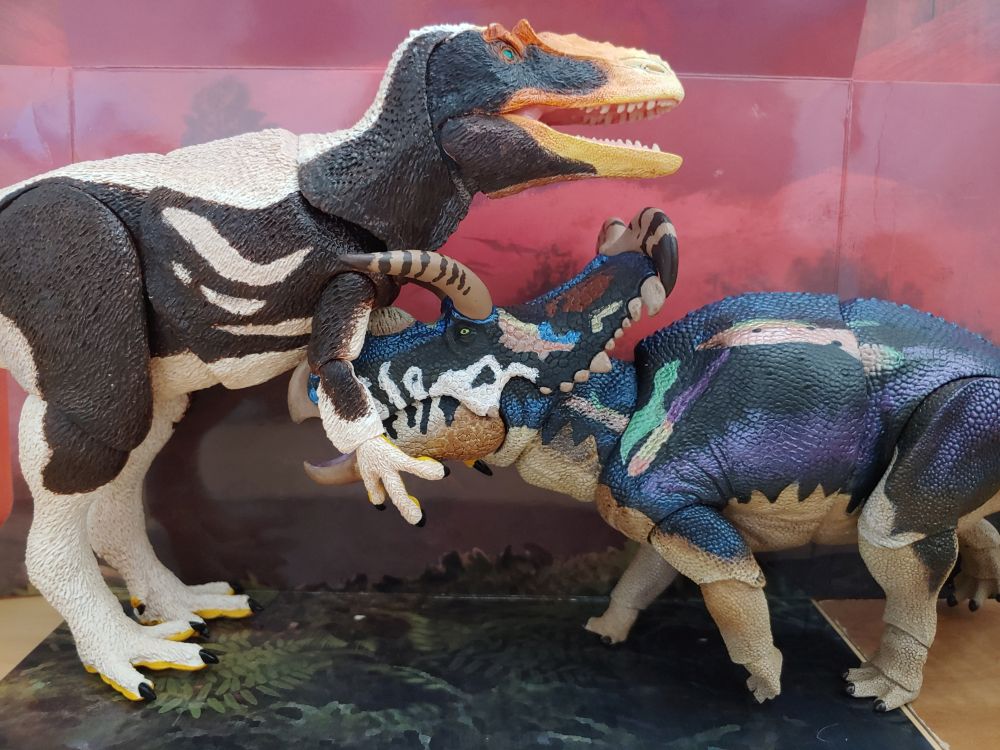
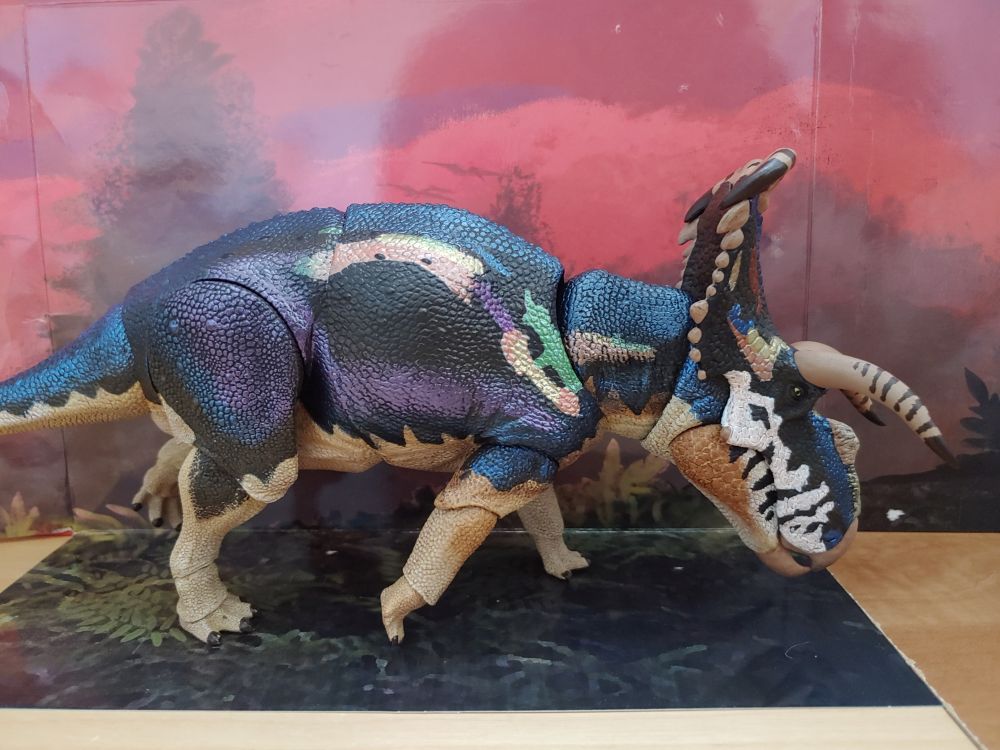
Last but not least is certainly the brilliant iridescent coloration of this figure, perhaps the main draw to the figure really. As stated earlier in this review, the coloration was derived from the iridescent white-lipped python, probably Leiopython albertisii. Like the snake, this figure certainly has a mix of white on the snout, and again iridescent coloration on the body. In total the face has a mix of white, black, iridescent blue, orange and cream on the jaw, tan and brown stripes on the horns, a brick red on the eye spots on the frill, and even a little bit of metallic gold and orange. Moving down the neck there are splotches and flecks of metallic orange, yellow, green and purple, with most of the body being primarily a mix of metallic blue and purple, and black here and there. The underside from the lower jaw down to the tip of the tail is primarily a cream coloration, with a wash to bring out the detail. The end result is a striking mix of colors, and iridescence that pleases the eye. It also gives the figure some form of counter shading, which other ornithischians like the nodosaurid Borealopelta (see my prior review, which goes into detail about this aspect), or the ceratopsian Psittacosaurus, have been found to be preserved with. As mentioned earlier David Silva painted up the prototype (in February 2022) that would serve as the paint reference for the mass produced plastic figures. It’s incredible to see how close the final factory produced paint application has come, though the most notable difference to me is that the metallic blue used on the snout and frill were of a lighter coloration, but that may be due to the difference in paints used, and perhaps lighting as well.
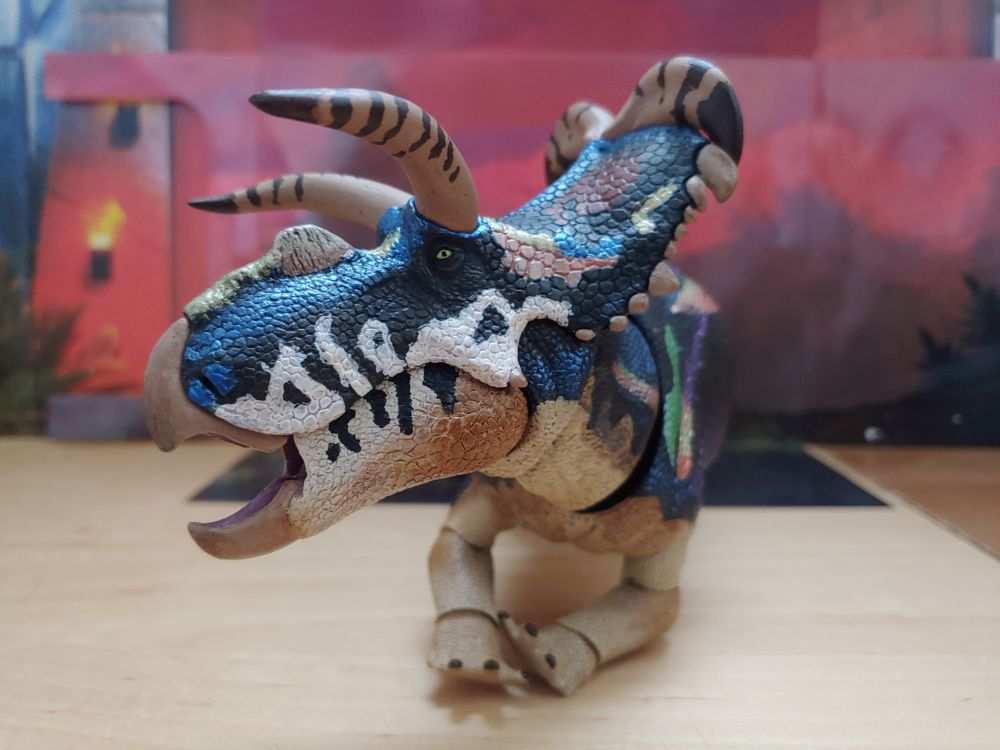

This figure was a gift from my mother earlier in the year, and came as a total surprise to me. Now it is easily one of my favorites of the ceratopsian series, despite the minor QC issue on mine. If anyone likes iridescence on dinosaurs, or is a fan of ceratopsians in general, I think this one is fully worth the price. It is still available on the Creative-Beast website, Dan’s Dinosaurs, Happy Hen Toys, Everything Dinosaur, Mini Zoo, if not other retailers that carry these figures. The aforementioned skull sculpted by Raul Ramos is also still available as a 3D print on the Creative Beast shapeways store in both 1/18 and 1/12 scale. Special thanks as well to forum member Halichoeres with some of the research help, allowing me to have a more thorough approach for this review.
Disclaimer: links to Ebay and Amazon on the DinoToyBlog are affiliate links, so we make a small commission if you use them. Thanks for supporting us!




Wow, this sets a new bar for citations! This is more thoroughly documented than some student theses I’ve read. Nicely done.
I really appreciate that! I’ve been trying to put more effort into my reviews on this front, and I’m glad it’s showing, and being received well. I mean I’ve come a long way since I’ve wrote my first little Yowie Anomalocaris review huh?
Thorough and enjoyable Post.
Am eager too acquire one of these figures for my home.
Big thank you.
Dennis
This was my most researched (as far as how many papers I read and dug through, although the Mattel Borealopelta’s came close), and probably one of my longest reviews, if not my longest. I spent nearly all year working on this on and off after I recieved the figure in March, and restarted this review several times over because of my chronic depression, etc. In any case this is my last gift to the Dinotoyblog and forum for 2023. Happy holidays, and happy new year. Next up from me is the CollectA Koolasuchus, hopefully finished sometime next month.
Congratulations on finishing it; this is an incredibly thorough breakdown of a magnificent figure!
This, along with the iconic Styracosaurus, is one of the two smaller BOTM ceratopsians in my collection. (I have all the ‘big guys’). As with the Styraco., the weird horn arrangements combined with the spectacular paint job made this one a “must buy”. Beautiful, obscure species piece by David Silva.